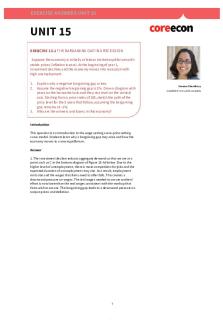Chapter 15 answers PDF

| Title | Chapter 15 answers |
|---|---|
| Author | Lola ChildShield |
| Course | Introductory Chemistry |
| Institution | University of Illinois at Urbana-Champaign |
| Pages | 4 |
| File Size | 121.5 KB |
| File Type | |
| Total Downloads | 91 |
| Total Views | 155 |
Summary
Chapter 15 questions and solutions...
Description
Chemistry104–Chapter15SummaryandReview–Answers 1. Thereactionofhydrogenandnitrogentoproduceammonia(theHaberprocess)takes placeinthegasphase. a. Whatisthebalancedequationforthisreaction? b. WhatistheexpressionforKPforthisreaction? c. WhatistheexpressionforKcforthisreaction? d. Ataparticulartemperature,iftheequilibriumconcentrationsare: Gas Concentration/M N2 0.0240 H2 0.0720 NH3 0.0520 WhatisthevalueofKc? e. WhatisthevalueofKPatthissametemperature? Answer: Parta:3H2(g)+N2(g) 2NH3(g) 2 PNH 3 Partb: KP PN PH3 2
2
NH Partc: Kc 3
2
N2 H2
3
Partd:Let’suse500K:
Parte:Continuingtouse500K:
NH3 0.0520 3 3 302 N2 H2 0.0240 0.0720 2
Kc
2
K c 302 KP RT
KP Kc RT
n gas
0.179
ngas
1 1 302 0.08206L atm mol K 500K
2
2. Forthesamereaction(asnumber1),ifthepartialpressuresofallthegasesareequalat 0.550atm,isthereactionatequilibrium? a. Ifnot,whichdirectionwillthereactionshifttoachievethisequilibrium? b. SetuptheICEtableforthiscalculationbasedonyourpreviousanswer. c. Ifthetemperatureisdecreased,theconcentrationschangeto: Concentration/M Concentration/M Gas (500K) (298K) N2 0.0240 0.00179 H2 0.0720 0.00537 NH3 0.0520 0.100 Isthereactionexothermicorendothermic?Usetheenthalpyofformationof ammoniatosupportthisclaim. d. Willincreasingthevolumeofthereactionvesselaltertheamountofammonia produced? e. Howwouldaddingmorehydrogenorremovingammoniashiftthereaction? 2 PNH 0.550 3 3.31 3 PN2 PH2 0.550 0.550 3 2
Answer: Parta:QP
QP KP
No,thereactionisnotatequilibrium.Thereactionwillshifttotheleft (tomakemorereactant)toestablishequilibrium.
Partb:
N2 g
3H2 g
initial
0.550atm
0.550atm
0.550atm
change
x
3x
2 x
equilibrium
0.550 x
0.550 3 x
0.550 2 x
2NH 3 g
Partc: Evaluatingtheconcentrations,theproductincreasesinpartialpressure andthereactantsbothdecrease.Therefore,thatsuggeststhat Kc,298K>Kc,500Kwhichalsomeansthatasthetemperatureincreases,the equilibriumconstantdecreases.Thatsuggeststhatthereactionis exothermic. Let’scheckthatwithacalculationofKc’s:
0.0520 2 3 302 0.0240 0.0720 2 0.100 3.61 10 7 K c,298K 3 0.00179 0.00537 K c,500K
K c,298K K c,500K
Andnowcheckthiswithcalculatingchangeinenthalpy(ΔHo)using appendix2: H
o f
N2 g
3H2 g
2NH3 g
0.0
0.0
46.3kJ mol1
o H reaction
nH products mH reactants 2molNH o f
o f
3
46.3kJ 92.6kJ molNH3
Partd:Yes,ifthevolumeisincreased,thisfavorsthegreaternumberofmolesof gas.Becausethereare4molesofgasreactingtoform2molesofgas,a greatervolumefavorsthereactantsortheamountofammoniaproduced woulddecrease. Parte:Addingmorehydrogenwouldshiftthereactiontoproducemore product;removingammoniawoulddothesame. 3. ForthereactionofN2O4toNO2,thereactionisbegunwith20.0gN2O4withnoNO2and thefinalpressureinthe5.0Lcontainerat298Kis1.90atm. a. Whatisthevalueoftheequilibriumconstant,KP? b. IsthevalueofKcthesameasKP?Ifnot,whatisthevalueofKc? c. UsingAppendix2,howwouldincreasingthetemperaturechangeKP? Answer: Parta:WehavetodeterminewhattheinitialpartialpressureofN2O4whichwas aregoingtodousingwhatweknowaboutformulacalculations(Chapter 3)andgases(Chapter5):
molN2O 4 92.02gN 2O 4
20.0gN2O4 PN2 O4
nN2 O4 RT
V
0.217molN 2O 4 initial
0.217mol 0.08206L atm mol 1 K 1 298K 5.0L
1.06atm
Now,wearegoingtosetupourICEtable: N2O 4 g
initial change
1.06atm x 1.06 x
equilibrium
2NO 2 g
0atm 2 x 2x
Thefinalpressureis1.90atm(PT).FromChapter5,wealsoknow: PT PN O PNO so: 1.90atm 1.06atm x 2 x x 0.84atm 2 4
2
Therefore, PN O 0.22atmandPNO 1.68atm 2 4
2
Finally, KP
1.68 0.22
2
2 PNO 2
PN 2O 4
13
Partb:KcandKPareequalwhenthenumberofmolesofgasonboththeproduct andreactantsideareequal(orΔngas=0).Because1moleofgas(N2O4) reactstoform2molesofgas(NO2),Δngas≠0andratherequals1. Therefore,Kc≠KP:
K c K P RT
n gas
13 0.08206L atm mol 1 K 1 298K 0.53 1
Partc: Toanswerthis,thereferencetoAppendix2wasthehint.Weneedto firstcalculatetheenthalpyofreaction.Ifitisendothermic,anincreasein temperaturewillincreasethevalueofK;ifitisexothermic,anincreasein temperaturewilldecreasethevalueofK: N2 O4 g
H
o f
1
9.66kJ mol
2NO2 g 33.85kJ mol 1
33.85kJ 9.66kJ H oreaction 2molNO2 1molN2 O4 58.04kJ molNO 2 molN 2O 4
Thereactionisendothermic(ΔHo>0),therefore,anincreasein temperaturewouldincreasetheequilibriumconstant....
Similar Free PDFs

Chapter 15 answers
- 4 Pages

Chapter-15 - chapter 15
- 18 Pages

Chapters 15 answers
- 8 Pages

Practice Sheet 15 Answers
- 4 Pages

15, questions and answers
- 19 Pages

Chapter 15
- 73 Pages

Chapter 15
- 21 Pages

Chapter 15
- 34 Pages

Chapter 15
- 11 Pages

Chapter 15
- 27 Pages

Chapter 15
- 2 Pages

Chapter 15
- 9 Pages

Unit 15 Answers to exercises
- 14 Pages
Popular Institutions
- Tinajero National High School - Annex
- Politeknik Caltex Riau
- Yokohama City University
- SGT University
- University of Al-Qadisiyah
- Divine Word College of Vigan
- Techniek College Rotterdam
- Universidade de Santiago
- Universiti Teknologi MARA Cawangan Johor Kampus Pasir Gudang
- Poltekkes Kemenkes Yogyakarta
- Baguio City National High School
- Colegio san marcos
- preparatoria uno
- Centro de Bachillerato Tecnológico Industrial y de Servicios No. 107
- Dalian Maritime University
- Quang Trung Secondary School
- Colegio Tecnológico en Informática
- Corporación Regional de Educación Superior
- Grupo CEDVA
- Dar Al Uloom University
- Centro de Estudios Preuniversitarios de la Universidad Nacional de Ingeniería
- 上智大学
- Aakash International School, Nuna Majara
- San Felipe Neri Catholic School
- Kang Chiao International School - New Taipei City
- Misamis Occidental National High School
- Institución Educativa Escuela Normal Juan Ladrilleros
- Kolehiyo ng Pantukan
- Batanes State College
- Instituto Continental
- Sekolah Menengah Kejuruan Kesehatan Kaltara (Tarakan)
- Colegio de La Inmaculada Concepcion - Cebu


